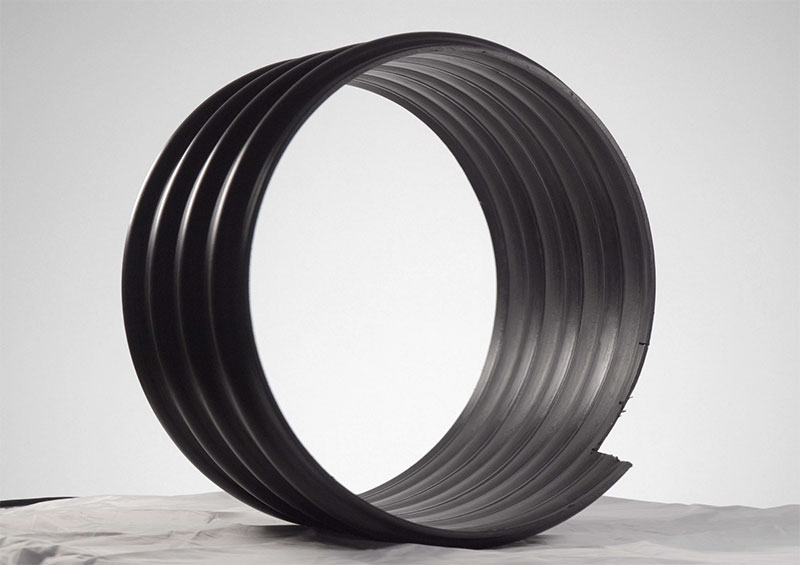What is the type, nature and use of plastic PE? The following follows the polyethylene composite pipe manufacturers to understand:
First, the basic characteristics of PE
PE is an abbreviation for polyethylene, which is formed by free radical polymerization of ethylene monomer. Its structural formula is as follows:
1. Structural characteristics of PE
PE is a linear polymer, a long-chain aliphatic hydrocarbon with a spatial zigzag arrangement of molecular chains; it is a highly flexible thermoplastic polymer with molecular symmetry and no polar groups. The intermolecular forces are small, which determines that the molecular weight of PE can be repeatedly folded and crystallized.
2. Physical properties of PE
PE is an odorless, non-toxic, milky white waxy solid; density 0.91~0.96g/cm3; low permeability, but high permeability, flammable polymer material.
The mechanical properties of PE are generally soft and tough. In the mechanical properties of PE, in addition to the higher impact strength, other mechanical properties are lower in plastics.
3, PE performance
PE has good chemical stability, generally not soluble in solvents below 60 ° C, but not resistant to strong oxidants.
The heat resistance of PE is not high, the Tg is very low in plastics, the low density polyethylene LDPE uses a temperature of <80 ° C, and the high density polyethylene HDPE uses a temperature of <121 ° C.
Electrical properties: Excellent (no polarity, low hygroscopicity), PE dielectric loss and constant are almost independent of temperature and frequency, can be used for high frequency insulation (+ antioxidants).
Sunlight causes the product to become brittle. Cause: The carbonyl group formed by oxidation absorbs light waves, and some high-energy rays illuminate, causing cross-linking and discoloration (+ carbon black). Improvement pathway: increasing PE molecular weight, reducing molecular weight dispersion, and proper cross-linking of molecular chains .

Second, the type and use of PE
1. Common polyethylene varieties
Different types of polyethylene can be obtained by different polymerization processes. The most common are high density polyethylene and low density polyethylene.
Low-temperature low-pressure method can produce high-density polyethylene HDPE, which is characterized by less branching, high density, high degree of regularity, easy crystallization, poor transparency and high strength. High-temperature and high-pressure method can produce low-density polyethylene LDPE, which is characterized by more branches, low density and poor regularity. It has a wide molecular weight distribution, low strength and good transparency.
The difference between LDPE and HDPE, because LDPE contains more branches in the main chain due to the active radical transfer of the chain during the synthesis process, generally 1000 C has 20-30 side methyl groups in the main chain, so HDPE In comparison, it has a lower crystallinity, so its product has better transparency, better fluidity, lower density, and lower mechanical properties.
These differences have determined that LDPE is widely used in agricultural films, mulch films, various light and heavy packaging films, woven linings, coatings, various pipes, wire and cable coating and other fields. HDPE is widely used in the packaging of hollow containers, injection containers, fish nets, pipes, mechanical parts and other fields.
2, special varieties of polyethylene
Ultra-high molecular weight polyethylene (UHMW-PE), synthesized by low-pressure polymerization, has a molecular weight of usually 1 to 3 million, up to 6 to 7 million; its molecular structure is basically the same as that of HDPE, and its crystallinity is 70 to 85%. Linear structure with excellent wear resistance, outstanding high modulus, high toughness and environmental stress crack resistance.
Due to its high molecular weight and high melt viscosity, it is inconvenient for processing. It is usually pressed and sintered by powder; extrusion molding is carried out by adding low molecular weight PE or auxiliary.
Due to its superior mechanical properties, its main applications are various mechanical parts, artificial joints, UHMW-PE fibers (cables, fishing nets, body armor, skis, etc.), auto parts, ropes, plain bearings, bushings and other fields.
Low molecular weight polyethylene (LMWPE), such as polyethylene wax, is mainly used as a plastic processing aid. Its main function is to adjust its processing fluidity. Other resin regulating properties of fillers, such as some waxy PU products, are widely used.
Linear low density polyethylene (LLDPE) can be prepared mainly by copolymerization of ethylene with an α-olefin such as propylene, 1-butene, 1-octene or the like. Mainly used in some film products, silk products and other fields.
Polyethylene cross-linking (X-PE) can be carried out by radiation, chemical methods, etc., and can be polyethylene cross-linking (X-PE), mainly used in wires, cables, heat shrinkable tubes and the like.
Third, the basic processing method of PE
PE processing is mainly carried out in a molten state, such as injection molding, extrusion, blow molding, pressing, and the like.
have to be aware of is:
Due to the hydrophobic nature of PE, the hygroscopicity is very low, and the raw materials need not be dried before processing.
Care should be taken to select the appropriate melt flow rate (MFR) during processing.
Injection molding and film blow molding: PE melt flow rate is high, molecular weight distribution is narrow, and there are fewer branches.
Extrusion and hollow blow molding: PE melt flow rate is low, molecular weight distribution is wide to ensure smooth surface of the product.